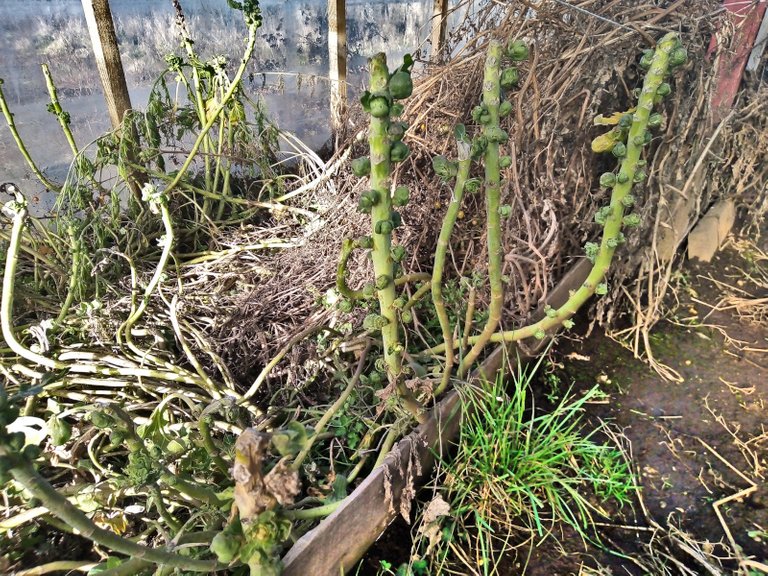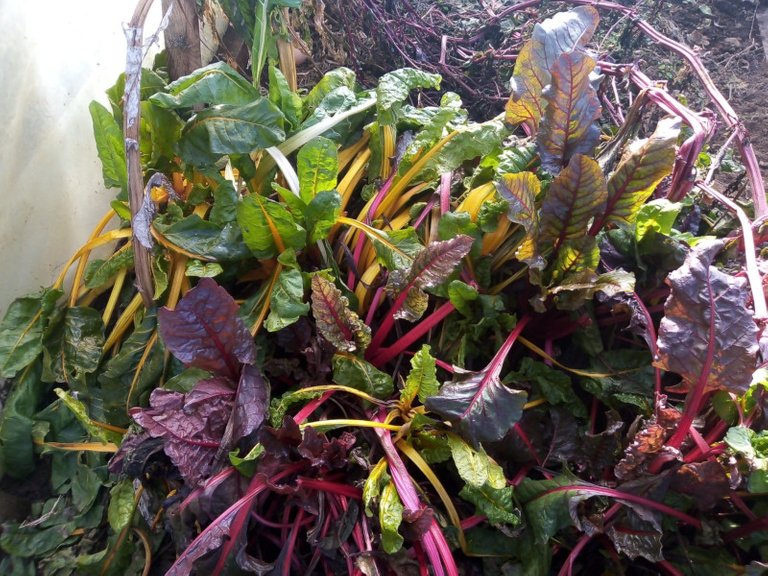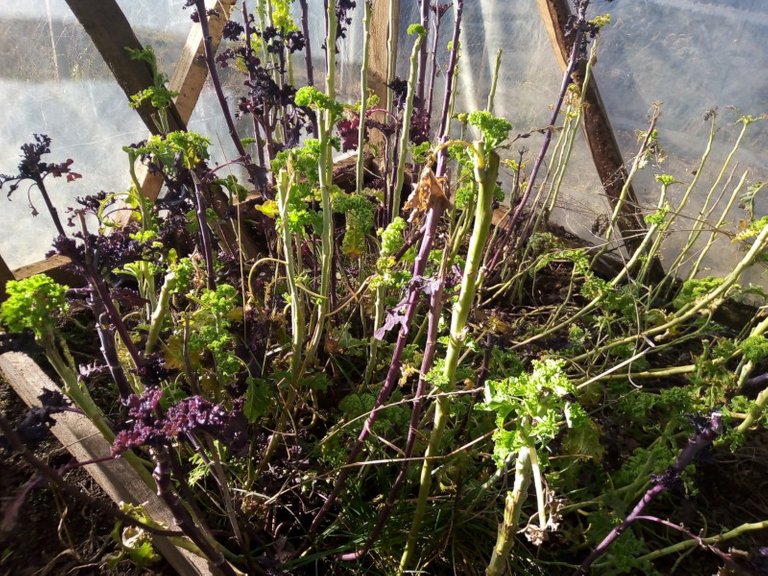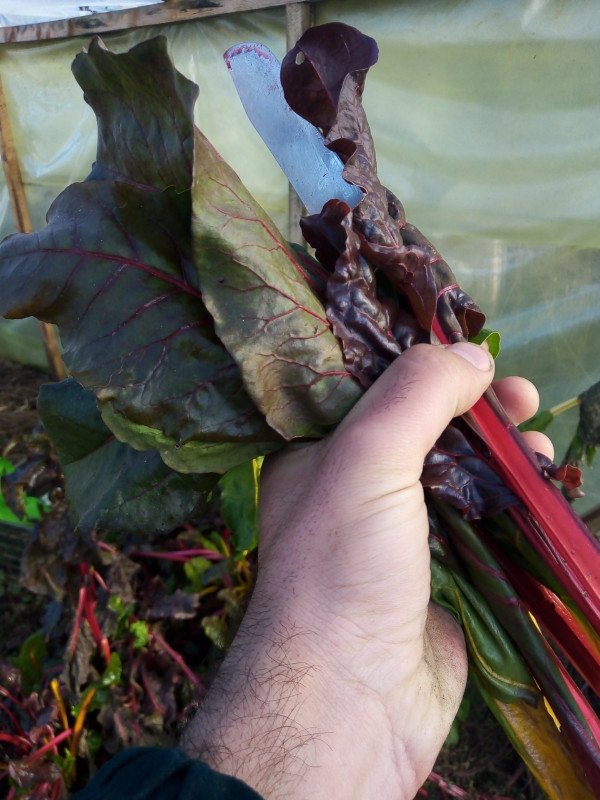
[ENG]
We're reaching the end of winter here in Chile and there are little precious greens to be eaten. The abundance of mushrooms brought by the autumn is long gone and the wild edibles are only beginning to rise from under the snow. However, in my mother's greenhouse three plants have managed to do just fine, despite no one tending to them throughout the whole winter.
Their resilience and ability to thrive during the cold months make them perfect plants to plant at your homestead so that you can have fresh veggies during the transition from winter to spring.
1 . Brussel sprouts

Brussel sprouts are often looked down upon because of how tasteless they are when bought frozen in the market. However, I can tell you first hand that eating them fresh from the garden is a different story altogether.
The plants in the photo were seeded in August last year and are still providing brussel sprout heads to this day, one year after.
Preparing the soil
To grow brussel sprouts it's recommended to dig 2 inches deep into the soil and press lightly to compact, reducing the air gaps that could lead to a disease known as club root, which makes the roots deform into gnarly knots and nodules which prevent water and nutrient intake.
Brussel sprouts requirements (source)
- Nitrogen rich soil
- Alkaline soil (7-7.5 ph)
- 5 to 7 hours of daily sunlight
- 1/2 gallon of water a week
- 10 - 11 inches of separation between each plant
- 45° - 85° F for germination (7° - 29° C)
- 110 -130 days before harvest
Harvest
Once the first leaves begin to turn yellow, it's recommended to break them away half an inch away from the base. 2 - 3 inches of leaves should be left untouched at the top so that the plant can still get nutrients from photosynthesis and the heads should be harvested once they've reached 1 - 2 inches in diameter. Harvesting in cold weather will provide a slightly sweeter flavor.
Nutritional information for brussel sprouts
According to this source, brussel sprouts provide decent amounts of:
- Protein (3.98 g per cup)
- Vitamin C and K, meeting the daily intake required
- High amount of calcium
- Alpha-lipoic acid (ALA)
- Sulphur-containing compunds
- Vitamin B-6
- Folate
- Potassium
Health benefits
With all these nutrients they provide the following health benefits (source):
- Prevent DNA damage
- Metastatic cancer spread
- Activate defenses against pathogens and pollutants
- Prevent lymphoma
- Target breast cancer stem cells
- Reduce the risk of prostate cancer progression
Like other cruciferous vegetables, Brussels are rich in a component called sulphoraphane, which according to this source:
Beyond being a promising anticancer agent, sulforaphane may also help protect your brain and your eyesight, reduce nasal allergy inflammation, manage type 2 diabetes, and was recently found to successfully help treat autism. A placebo-controlled, double-blind, randomized trial of boys with autism found that about two to three cruciferous vegetable servings’ worth of sulforaphane a day improves social interaction, abnormal behavior, and verbal communication within a matter of weeks. The researchers, primarily from Harvard University and Johns Hopkins University, suggest that the effect might be due to sulforaphane’s role as a “detoxicant.”
2 . Chard

I'm guessing by now few are strangers to growing chard in their gardens. These are the battle horses of anyone looking to be self-sufficient and provide healthy food for their homes as they are hard to kill, cold-resistant, and super easy to reproduce.
It's not necessary to write much about their growing needs as they can adapt to a variety of soils, however, if you provide plenty of organic matter and nutrients you can expect way better flavor and higher yields.
The plants you can see in the picture were not intentionally placed there, rather they grew from seeds that fell off an earlier production.
There is a catch though:
Most people tend to remove the leaves that freeze during the winter. In this case, the frozen leaves were left as protection for the smaller plants that were growing underneath, which helped have a healthy production even in the coldness of this winter.
Nutritional information for chard
Did you know one cup of chard has 3 times the necessary amount of vitamin K you need in a day? Here are some other nutrients you can find in this wonderful crop (source):
- High level of nitrates
- 44% recommended amount of vitamin A
- Considerable amounts of iron, calcium, magnesium, phosphorous, potassium, vitamins C and E, as well as folates.
- Antioxidants alpha and beta-carotene, lutein, zeaxanthin, and choline.
- Good source of chlorophyll
- Contains alpha-lipoic acid (ALA)
Health benefits of chard
- Repairs cell damage
- Reduces cardiovascular disease risk
- Slows cognitive decline
- Combats cancer
- Lowers glucose levels
- Prevents osteoporosis
- Improves athletic performance
3 . Kale

Kale has gained lots of popularity lately as one of the most nutritious veggies out there. It grows on all climates and despite preferring full sunlight, it can tolerate partial shade.
The kale in the picture are overwintered and have been harvested several times, still giving new leaves in this time of year.
Soil preparation
Kale requires lots of nutrients so it's a good idea to add compost generously before planting. If you decide to grow in containers you'll have to consider a depth of at least 10 inches deep.
When to plant
Since kale is highly adaptable to different temperatures, you can decide to seed it according to when you would like to begin harvesting. Kale takes around 50 to 65 days to mature, so keep that in mind. Check out your local frost dates and go for approximately 6 weeks before them.
Nutritional information for kale
One cup of raw kale offers (source):
- Nearly 3 grams of protein
- More vitamins A, C, and K than the daily requirements
- Folate
- ALA
- Good amounts of phosphorus, potassium, calcium, and zinc
- Lutein and zeaxanthin antioxidants
Health benefits of kale
- Skin enhancement
- Protection against glaucoma
- Mood booster
- Reduce cholesterol
- Prevent DNA damage
- Improve immune function
- Prevents kidney and breast cancer
- Increase cancer survival
According to Nutrition Facts, this veggie also:
Is one of the more effective bile acid-binding vegetables, which may play a role in lowering the risk of premature degenerative diseases. To avoid interfering with thyroid function, a person must be careful not to eat too much of it raw. Chopping it and then waiting at least 40 minutes before cooking it or mixing some mustard powder to cooked kale helps produce the anti-cancer nutrient, sulforaphane.
So, there you go! Three easy to grow crops, packed with nutritional value, and resistant enough to cold so that you can have a nice yield when there are scarce veggies all around.
Would you recommend any other crops on this list? Feel free to let us know in the comments 🤗

[[Growing food is a revolutionary act]]
[ESP]
Estamos llegando al final del invierno aquí y menos verduras que en otras estaciones para comer. Sin embargo, en el invernadero tenemos tres cultivos que se las arreglan bien a pesar de no haber recibido cuidados durante todo el invierno.
Su resistencia y su capacidad para prosperar durante los meses fríos los convierten en plantas perfectas para plantar en su granja para que pueda tener verduras frescas durante la transición del invierno a la primavera.
1 . Bruselas

Las bruselas a menudo son menospreciadas por el poco sabor que tienen cuando se compran congeladas en el mercado. Sin embargo, comerlos frescos del jardín es otra historia.
Las plantas en la foto fueron sembradas en agosto del año pasado y todavía están dando alimento hasta el día de hoy, un año después.
Preparar el suelo
Para cultivar bruselas, se recomienda cavar 2 pulgadas de profundidad en el suelo y presionar ligeramente para compactar, reduciendo los espacios de aire que podrían conducir a una enfermedad que hace que las raíces se deformen en nudos y nódulos nudosos los cuales evitan la absorción de agua y nutrientes.
Requisitos para las coles de Bruselas
- Suelo rico en nitrógeno
- Suelo alcalino (7-7.5 ph)
- 5 a 7 horas de luz solar diaria
- Humedad constante en el suelo
- 10 - 11 pulgadas de separación entre cada planta
- 7 ° - 29 ° C para germinación
- 110-130 días antes de la cosecha
Cosecha
Una vez que las primeras hojas comienzan a ponerse amarillas, se recomienda cortarlas a media pulgada de la base. Las hojas deben dejarse intactas en la parte superior para que la planta pueda obtener nutrientes de la fotosíntesis y las cabezas se deben cosechar una vez que hayan alcanzado 1 a 2 pulgadas de diámetro. La cosecha en tiempos de frío proporcionará un sabor ligeramente más dulce.
Información nutricional para las coles de Bruselas
De acuerdo con esto, las coles de Bruselas proporcionan cantidades decentes de:
- Proteína (3.98 g por taza)
- Vitamina C y K, que satisfacen la ingesta diaria requerida
- Alta cantidad de calcio
- Ácido alfa lipoico
- Compuestos que contienen azufre
- Vitamina B-6
- Ácido fólico
- Potasio
Beneficios de la salud
Con todos estos nutrientes proporcionan los siguientes beneficios para la salud:
- Prevenir daños en el ADN
- Evitan propagación del cáncer metastásico
- Activa las defensas contra agentes patógenos y contaminantes
- Previene el linfoma
- Apuntan contra las células madre del cáncer de mama
- Reduce el riesgo de progresión del cáncer de próstata
Al igual que otras verduras crucíferas, Bruselas es rica en un componente llamado sulforafano, que de acuerdo con esto:
Además de ser un agente anticancerígeno prometedor, el sulforafano también puede ayudar a proteger su cerebro y su vista, reducir la inflamación de la alergia nasal, controlar la diabetes tipo 2 y recientemente se descubrió que ayuda a tratar el autismo con éxito. Un estudio (...) con placebo de niños con autismo encontró que alrededor de dos o tres porciones de verduras crucíferas en sulforafano al día mejora la interacción social (...) y la comunicación verbal en cuestión de semanas. Los investigadores, principalmente de la Universidad de Harvard y la Universidad Johns Hopkins, sugieren que el efecto podría deberse al papel del sulforafano como "desintoxicante".
2 . Acelga

A estas alturas pocos son ajenos a las acelgas en sus huertos. Estos son los caballos de batalla de cualquiera que busque ser autosuficiente y proporcionar alimentos saludables para sus hogares, ya que son resistentes al frío y muy fáciles de reproducir.
No es necesario escribir mucho sobre sus necesidades de crecimiento, ya que pueden adaptarse a una variedad de suelos, sin embargo, sí proporciona abundante materia orgánica y nutrientes, puede esperar un mejor sabor y mayores rendimientos.
Las plantas que puede ver en la imagen no se colocaron allí intencionalmente, sino que crecieron a partir de semillas que se cayeron de una producción anterior.
Sin embargo, hay una consideración:
La mayoría de las personas tienden a eliminar las hojas que se congelan durante el invierno. En este caso, las hojas congeladas se dejaron como protección para las plantas más pequeñas que crecían debajo, lo que ayudó a tener una producción saludable incluso en el frío de este invierno.
Información nutricional de la acelga
¿Sabías que una taza de acelgas tiene 3 veces la cantidad necesaria de vitamina K que necesitas en un día? Aquí hay algunos otros nutrientes que puedes encontrar en este maravilloso cultivo:
- Alto nivel de nitratos
- 44% cantidad recomendada de vitamina A
- Cantidades considerables de hierro, calcio, magnesio, fósforo, potasio, vitaminas C y E, así como folatos
- Antioxidantes alfa y betacaroteno, luteína, zeaxantina y colina
- Buena fuente de clorofila
- Contiene ácido alfa lipoico
Beneficios para la salud de la acelga
- Repara el daño celular
- Reduce el riesgo de enfermedad cardiovascular
- Retrasa el deterioro cognitivo
- Combate el cáncer
- Reduce los niveles de glucosa
- Previene la osteoporosis
- Mejora el rendimiento deportivo.
3 . Kale

El kale ha ganado mucha popularidad últimamente como una de las verduras más nutritivas que existen. Crece en todos los climas y, a pesar de preferir la luz solar total, puede tolerar la sombra parcial.
El kale en la imagen se pasa el invierno y se ha cosechado varias veces, aún dando nuevas hojas en esta época del año.
Preparación del suelo
El kale requiere muchos nutrientes, por lo que es una buena idea agregar compost generosamente antes de plantar. Si decide crecer en contenedores, deberá considerar una profundidad de al menos 10 pulgadas de profundidad.
Cuando plantar
Dado que el kale es altamente adaptable a diferentes temperaturas, puede decidir sembrar de acuerdo a cuándo le gustaría comenzar a cosechar. Tarda alrededor de 50 a 65 días en madurar, así que tenlo en cuenta. Consulte las fechas de heladas locales y continúe durante aproximadamente 6 semanas antes de ellas.
Información nutricional para la col rizada
Una taza de kale cruda ofrece:
- Casi 3 gramos de proteína
- Más vitaminas A, C y K que los requerimientos diarios
- Ácido fólico
- Ácido alfa lipoico
- Buenas cantidades de fósforo, potasio, calcio y zinc
- Antioxidantes de luteína y zeaxantina
Beneficios para la salud de la col rizada
- Mejora de la piel
- Protección contra el glaucoma
- Refuerzo de humor
- Reduce el colesterol
- Prevenir daños en el ADN
- Mejora la función inmune
- Previene el cáncer de riñón y de mama
- Aumenta las posibilidades de sobrevivir al cáncer
En la página Nutrition Facts señalan que:
“Es una de las verduras más eficaces que se unen a los ácidos biliares, que pueden desempeñar un papel en la reducción del riesgo de enfermedades degenerativas prematuras. Para evitar interferir con la función tiroidea, una persona debe tener cuidado de no comer demasiada kale cruda. Picarlo y luego esperar al menos 40 minutos antes de cocinarlo o mezclar un poco de mostaza en polvo con kale cocida ayuda a producir el nutriente anticancerígeno sulforafano”.
¡Ya saben! Tres cultivos fáciles de cultivar, repletos de valor nutricional y lo suficientemente resistentes al frío para que pueda tener un buen rendimiento cuando hay pocas verduras por todas partes.
¿Recomendarían algún otro cultivo en esta lista? No duden contarnos en los comentarios.

[[Sembrar tus alimentos es un acto revolucionario]]
We ALWAYS have chard or silver beet growing in our garden. I always let it self seed (like most of the greens) so I have abundance when it wants to come. I love making palak paneer from it. I've never had success with brussel sprouts.
Congratulations @fenngen! You have completed the following achievement on the Hive blockchain and have been rewarded with new badge(s) :
You can view your badges on your board And compare to others on the Ranking
If you no longer want to receive notifications, reply to this comment with the word
STOPTo support your work, I also upvoted your post!
Do not miss the last post from @hivebuzz:
You got 3 of my favourite veg right there, I am growing chard and Kale but have yet to plant Brussel sprouts, waiting for summer to end. I must say roasted brussel sprouts are my favourite with some garlic and thyme, yum xxx
Curated for #naturalmedicine by @trucklife-family.

We encourage content about health & wellness - body, mind, soul and earth. We are an inclusive community with two basic rules: Proof of Heart (kindness prevails) & Proof of Brain (original content). Read more here.
Our website also rewards with its own Lotus token & we'd love you to join our community in Discord. Delegate to @naturalmedicine & be supported with upvotes, reblog, tips, writing inspiration challenges for a chance to win HIVE and more. Click here to join the #naturalmedicine curation trail!
We also encourage you to follow our sister accounts, @lotusshares and @uplotus. We're also partnered with another amazing healing group, @adiwathrive - follow for dual language curation (English and Spanish), spiritual, musical and heart centred wellness!
@trucklife-family they're awesome and delicious! Thanks for the support :D
You did a great write up and it, it was very well detailed.